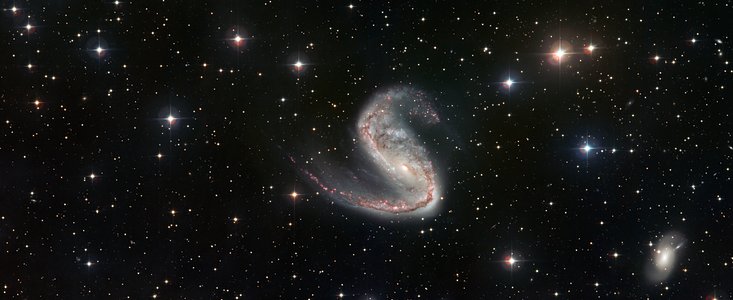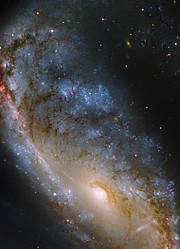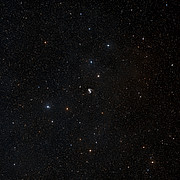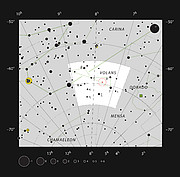Pressemitteilung
Zwei Ansichten einer Galaxie mit Schlagseite
4. Mai 2011
Das Erscheinungsbild er “Fleischerhaken-Galaxie” NGC 2442 ist stark asymmetrisch: Einer ihrer Spiralarme ist eng gewunden; in diesem Arm fand vor kurzem eine Supernova-Explosion statt. Der andere Spiralarm erstreckt sich vom Kern der Galaxie weit nach außen und beherbergt die Kinderstuben vieler junger Sterne. Aufnahmen des MPG/ESO 2,2-Meter-Teleskops und des NASA/ESA Hubble-Weltraumteleskops zeigen zwei sehr unterschiedliche Ansichten der Galaxie.
Die Fleischerhaken-Galaxie (Katalogbezeichnung NGC 2442) im südlichen Sternbild Volans (zu deutsch der „fliegende Fisch“) ist leicht an ihren asymmetrischen Spiralarmen zu erkennen. Das charakteristische Erscheinungsbild der Galaxie dürfte durch Gezeitenwechselwirkungen mit einer anderen Galaxie verursacht worden sein. Bisher jedoch konnten die Astronomen weder den genauen Zeitpunkt dieser Begegnung noch den „Übeltäter“ ausfindig machen.
Das hier gezeigte Übersichtsbild wurde mit dem Wide Field Imager am MPG/ESO 2,2 Meter Teleskop auf La Silla in Chile aufgenommen. Es zeigt sehr deutlich die Doppelhaken-Form, der die Galaxie ihren Spitznamen verdankt. Auch einige andere Galaxien in der Nähe von NGC 2442 sowie viele weit entfernte Hintergrundgalaxien sind deutlich zu sehen. Zwar erreichen die vom Boden aus gewonnen Aufnahmen des Wide Field Imagers nicht die Bildschärfe des Hubble-Weltraumteleskops. Dafür zeigt jedes Bild einen viel größeren Himmelsausschnitt als bei Hubble-Aufnahmen. Um beide Vorteile zu nutzen, verwenden Astronomen nicht selten eine Kombination von Aufnahmen beider Instrumente.
Eine Nahaufnahme des NASA/ESA-Weltraumteleskops Hubble (eso1115b) zeigt den Kern der Galaxie und den kompakteren der beiden Spiralarme. In diesem Spiralarm explodierte 1999 ein massereicher Stern am Ende seines Lebens als Supernova. Der Vergleich dieser Aufnahme aus dem Jahr 2006 mit Hubble-Bildern aus dem Jahr 2001 und älteren Aufnahmen bodengebundener Teleskope ermöglichte es den Astronomen, den Tod des Sterns im Detail zu untersuchen. Zum Zeitpunkt der hier gezeigten neuen Aufnahme war die Supernova selbst bereits soweit verblasst, dass sie nicht mehr erkennbar ist.
Durch die ESO-Beobachtungen wird auch das andere Ende des Lebenszyklus der Sterne in der Hubble-Aufnahme klar erkennbar: Überall in der Galaxie, und insbesondere im längeren der beiden Spiralarme, zeigen sich rosa und rot leuchtende Sternentstehungsgebiete. Ihre Farbe zeigt die Anwesenheit von Wasserstoffgas, das von der Strahlung frisch geborener Sterne zum Leuchten angeregt wird.
Die derzeitige Episode heftiger Sternentstehung dürfte durch die gleiche Beinahe-Kollision mit einer anderen Galaxie ausgelöst worden sein, die der Fleischerhaken-Galaxie auch ihre eigenartige Form verliehen hat. Die dabei wirkenden Gezeitenkräfte haben nicht nur die Galaxie als ganzes verformt, sondern auch Gaswolken in ihrem Inneren kollabieren lassen.
Weitere Informationen
Das MPG/ESO 2,2-Meter-Teleskop wurde 1984 in Betrieb genommen und ist eine Leihgabe der Max-Planck-Gesellschaft an die ESO. Sein Wide Field Imager, eine astronomische Kamera mit besonders großem Blickfeld und einem Detektor mit 67 Millionen Pixeln, liefert Bilder, die nicht nur von wissenschaftlichem, sondern auch von ästhetischem Wert sind.
Die Europäische Südsternwarte ESO (European Southern Observatory) ist die führende europäische Organisation für astronomische Forschung und das wissenschaftlich produktivste Observatorium der Welt. Getragen wird die Organisation durch ihre 15 Mitgliedsländer: Belgien, Brasilien, Dänemark, Deutschland, Finnland, Frankreich, Italien, die Niederlande, Österreich, Portugal, Spanien, Schweden, die Schweiz, die Tschechische Republik und das Vereinigte Königreich. Die ESO ermöglicht astronomische Spitzenforschung, indem sie leistungsfähige bodengebundene Teleskope entwirft, konstruiert und betreibt. Auch bei der Förderung internationaler Zusammenarbeit auf dem Gebiet der Astronomie spielt die Organisation eine maßgebliche Rolle. Die ESO betreibt drei weltweit einzigartige Beobachtungsstandorte in Nordchile: La Silla, Paranal und Chajnantor. Auf Paranal betreibt die ESO mit dem Very Large Telescope (VLT) das weltweit leistungsfähigste Observatorium für Beobachtungen im Bereich des sichtbaren Lichts, sowie VISTA, das größte Durchmusterungsteleskop der Welt. Die ESO ist der europäische Partner für den Aufbau des Antennenfelds ALMA, das größte astronomische Projekt überhaupt. Derzeit entwickelt die ESO das European Extremely Large Telescope (E-ELT) für Beobachtungen im Bereich des sichtbaren und Infrarotlichts, mit 42 Metern Spiegeldurchmesser ein Großteleskop der Extraklasse.
Die Übersetzungen von englischsprachigen ESO-Pressemitteilungen sind ein Service des ESO Science Outreach Network (ESON), eines internationalen Netzwerks für astronomische Öffentlichkeitsarbeit, in dem Wissenschaftler und Wissenschaftskommunikatoren aus allen ESO-Mitgliedsstaaten (und einigen weiteren Ländern) vertreten sind. Deutscher Knoten des Netzwerks ist das Haus der Astronomie am Max-Planck-Institut für Astronomie in Heidelberg.
Links
Kontaktinformationen
Richard Hook
ESO, La Silla, Paranal, E-ELT and Survey Telescopes Public Information Officer
Garching bei München, Germany
Tel: +49 89 3200 6655
E-Mail: rhook@eso.org
Oli Usher
Hubble/ESA
Garching bei München, Germany
Tel: +49 89 3200 6855
E-Mail: ousher@eso.org
Markus Nielbock (Pressekontakt Deutschland)
ESO Science Outreach Network
und Haus der Astronomie
Heidelberg, Deutschland
Tel: +49 6221 528-134
E-Mail: eson-germany@eso.org
Über die Pressemitteilung
| Pressemitteilung Nr.: | eso1115de |
| Name: | NGC 2442 |
| Typ: | Local Universe : Galaxy : Type : Spiral |
| Facility: | Hubble Space Telescope, MPG/ESO 2.2-metre telescope |
| Instruments: | WFI |
Our use of Cookies
We use cookies that are essential for accessing our websites and using our services. We also use cookies to analyse, measure and improve our websites’ performance, to enable content sharing via social media and to display media content hosted on third-party platforms.
ESO Cookies Policy
The European Organisation for Astronomical Research in the Southern Hemisphere (ESO) is the pre-eminent intergovernmental science and technology organisation in astronomy. It carries out an ambitious programme focused on the design, construction and operation of powerful ground-based observing facilities for astronomy.
This Cookies Policy is intended to provide clarity by outlining the cookies used on the ESO public websites, their functions, the options you have for controlling them, and the ways you can contact us for additional details.
What are cookies?
Cookies are small pieces of data stored on your device by websites you visit. They serve various purposes, such as remembering login credentials and preferences and enhance your browsing experience.
Categories of cookies we use
Essential cookies (always active): These cookies are strictly necessary for the proper functioning of our website. Without these cookies, the website cannot operate correctly, and certain services, such as logging in or accessing secure areas, may not be available; because they are essential for the website’s operation, they cannot be disabled.
Functional Cookies: These cookies enhance your browsing experience by enabling additional features and personalization, such as remembering your preferences and settings. While not strictly necessary for the website to function, they improve usability and convenience; these cookies are only placed if you provide your consent.
Analytics cookies: These cookies collect information about how visitors interact with our website, such as which pages are visited most often and how users navigate the site. This data helps us improve website performance, optimize content, and enhance the user experience; these cookies are only placed if you provide your consent. We use the following analytics cookies.
Matomo Cookies:
This website uses Matomo (formerly Piwik), an open source software which enables the statistical analysis of website visits. Matomo uses cookies (text files) which are saved on your computer and which allow us to analyze how you use our website. The website user information generated by the cookies will only be saved on the servers of our IT Department. We use this information to analyze www.eso.org visits and to prepare reports on website activities. These data will not be disclosed to third parties.
On behalf of ESO, Matomo will use this information for the purpose of evaluating your use of the website, compiling reports on website activity and providing other services relating to website activity and internet usage.
Matomo cookies settings:
Additional Third-party cookies on ESO websites: some of our pages display content from external providers, e.g. YouTube.
Such third-party services are outside of ESO control and may, at any time, change their terms of service, use of cookies, etc.
YouTube: Some videos on the ESO website are embedded from ESO’s official YouTube channel. We have enabled YouTube’s privacy-enhanced mode, meaning that no cookies are set unless the user actively clicks on the video to play it. Additionally, in this mode, YouTube does not store any personally identifiable cookie data for embedded video playbacks. For more details, please refer to YouTube’s embedding videos information page.
Cookies can also be classified based on the following elements.
Regarding the domain, there are:
- First-party cookies, set by the website you are currently visiting. They are stored by the same domain that you are browsing and are used to enhance your experience on that site;
- Third-party cookies, set by a domain other than the one you are currently visiting.
As for their duration, cookies can be:
- Browser-session cookies, which are deleted when the user closes the browser;
- Stored cookies, which stay on the user's device for a predetermined period of time.
How to manage cookies
Cookie settings: You can modify your cookie choices for the ESO webpages at any time by clicking on the link Cookie settings at the bottom of any page.
In your browser: If you wish to delete cookies or instruct your browser to delete or block cookies by default, please visit the help pages of your browser:
Please be aware that if you delete or decline cookies, certain functionalities of our website may be not be available and your browsing experience may be affected.
You can set most browsers to prevent any cookies being placed on your device, but you may then have to manually adjust some preferences every time you visit a site/page. And some services and functionalities may not work properly at all (e.g. profile logging-in, shop check out).
Updates to the ESO Cookies Policy
The ESO Cookies Policy may be subject to future updates, which will be made available on this page.
Additional information
For any queries related to cookies, please contact: pdprATesoDOTorg.
As ESO public webpages are managed by our Department of Communication, your questions will be dealt with the support of the said Department.






